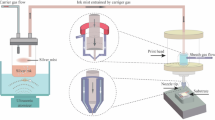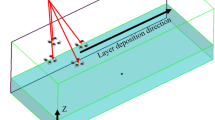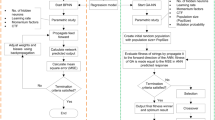Abstract
Aerosol jet printing (AJP) technology is a relatively new 3D printing technology for producing customized microelectronic components due to its high design flexibility and fine feature deposition. However, complex interactions between machine, process parameters and materials will influence line morphology and remain a challenge on modeling effectively. And the system drift which induced by many changing and uncertain factors will affect the printing process significantly. Hence, it is necessary to develop a small data set based machine learning approach to model relationship between the process parameters and the line morphology. In this paper, we propose a rapid process modeling method for AJP process and consider sheath gas flow rate, carrier gas flow rate, stage speed as AJP process parameters, and line width and line roughness as the line morphology. Latin hypercube sampling is adopted to generate experimental points. And, Gaussian process regression (GPR) is used for modeling the AJP process because GPR has the capability of providing the prediction uncertainty in terms of variance. The experimental result shows that the proposed GPR model has competitive modeling accuracy comparing to the other regression models.















Similar content being viewed by others
References
Daniel, J. (2010). Printed electronics: Technologies, challenges, and applications. In International workshop on flexible printed electronics, Muju Resort, Korea, September 8–10, 2010.
Jones, C. S., et al. (2010). Aerosol-jet-printed, high-speed, flexible thin-film transistor made using single-walled carbon nanotube solution. Microelectronic Engineering,87(3), 434–437.
Perez, K. B., & Williams, C. B. (2014). Design considerations for hybridizing additive manufacturing and direct write technologies. In ASME international design engineering technical conferences and computers and information in engineering conference, New York, USA, August 17–20, 2014.
Goth, C., Putzo, S., & Franke, J. (2011). Aerosol jet printing on rapid prototyping materials for fine pitch electronic applications. In Electronic components and technology conference, Florida, USA, May 31–June 3, 2011.
Mahajan, A., Frisbie, C. D., & Francis, L. F. (2013). Optimization of aerosol jet printing for high-resolution, high-aspect ratio silver lines. ACS Applied Materials & Interfaces,5(11), 4856–4864.
Salary, R. R., et al. (2017). Computational fluid dynamics modeling and online monitoring of aerosol jet printing process. Journal of Manufacturing Science and Engineering,139(2), 1–21.
Feng, J. Q. (2016). A computational study of high-speed microdroplet impact onto a smooth solid surface. Journal of Applied Fluid Mechanics,10(1), 1–26.
Vogeler, F., et al. (2013). An initial study into aerosol jet® printed interconnections on extrusion based 3D printed substrates. Journal of Mechanical Engineering,59(11), 689–696.
Wadhwa, A. (2015). Run-time ink stability in pneumatic aerosol jet printing using a split stream solvent add back system. Rochester Institute of Technology, 2015.
Smith, M., et al. (2017). Controlling and assessing the quality of aerosol jet printed features for large area and flexible electronics. Flexible and Printed Electronics,2(1), 2–11.
Verheecke, W. et al. (2012). Optimizing aerosol jet printing of silver interconnects on polyimide film for embedded electronics applications. In Eighth international DAAAM Baltic conference, Tallinn, Estonia, April 19–21, 2012.
Wang, K., et al. (2013). Evaluation of quality of printed strain sensors for composite structural health monitoring applications. In SAMPE fall technical conference, Wichita, USA, October 21–24, 2013.
Christenson, K. K., et al. (2011). Direct printing of circuit boards using aerosol jet ®,” NIP & Digital Fabrication Conference, Minnesota, USA, October 2–6, 2011.
Hedges, M., Marin, A. B. (2012). 3D aerosol jet printing-Adding electronics functionality to RP/RM. In DDMC conference, Berlin, Germany, March 15–16, 2012.
Tait, J. G., et al. (2015). Uniform aerosol jet printed polymer lines with 30 μm width for 140 ppi resolution RGB organic light emitting diodes. Organic Electronics,22(1), 40–43.
Salary, R. R., et al. (2017). Online monitoring of functional electrical properties in aerosol jet printing additive manufacturing process using shape-from-shading image analysis. Journal of Manufacturing Science and Engineering,139(10), 1–13.
Kopola, P., et al. (2012). Aerosol jet printed grid for ITO-free inverted organic solar cells. Solar Energy Materials and Solar Cells,107(1), 252–258.
Schulz, D., et al. (2010). Collimated Aerosol beam deposition: Sub-5 μm resolution of printed actives and passives. IEEE Transactions on Advanced Packaging,33(2), 421–427.
Akhatov, I. S., et al. (2009). Aerosol flow through a micro-capillary. In ASME second international conference on micro/nanoscale heat and mass transfer, Shanghai, China, December 18–21, 2009.
Binder, S., Glatthaar, M., & Rädlein, E. (2014). Analytical investigation of aerosol jet printing. Aerosol Science and Technology,48(9), 924–929.
Feng, J. Q. (2017). A computational study of particle deposition patterns from a circular laminar jet. Journal of Applied Fluid Mechanics,10(4), 1–19.
Rasmussen, C. E., & Williams, C. K. (2006). Gaussian process for machine learning. Berlin, Heidalberg: MIT press.
Hernández, N., et al. (2008). Relevance vector machines for multivariate calibration purposes. Journal of Chemometrics,22(11–12), 686–694.
Rasmussen, C. E. (1999). Evaluation of Gaussian processes and other methods for non-linear regression. University of Toronto, 1999.
Yuan, J., et al. (2008). Reliable multi-objective optimization of high-speed WEDM process based on Gaussian process regression. International Journal of Machine Tools and Manufacture,48(1), 47–60.
Tang, Q., et al. (2010). Response surface methodology using Gaussian processes: Towards optimizing the trans-stilbene epoxidation over Co2+–NaX catalysts. Chemical Engineering Journal,156(2), 423–431.
Chi, G., et al. (2012). Response surface methodology with prediction uncertainty: A multi-objective optimisation approach. Chemical Engineering Research and Design,90(9), 1235–1244.
Fang, K.-T., et al. (2000). Uniform design: Theory and application. Technometrics,42(3), 237–248.
Chang, J.-S., & Lin, J.-P. (2004). Product and process development via sequential pseudo-uniform design. Industrial and Engineering Chemistry Research,43(15), 4278–4292.
Kalagnanam, J. R., & Diwekar, U. M. (1997). An efficient sampling technique for off-line quality control. Technometrics,39(3), 308–319.
McKay, M. D., Beckman, R. J., & Conover, W. J. (1979). Comparison of three methods for selecting values of input variables in the analysis of output from a computer code. Technometrics,21(2), 239–245.
Chen, Y.-L., et al. (2015). Incremental Latin hypercube sampling for lifetime stochastic behavioral modeling of analog circuits. In Design automation conference, Tokyo, January 19–22, 2015.
Yan, S., & Minsker, B. (2006). Optimal groundwater remediation design using an adaptive neural network genetic algorithm. Water Resources Research,42(5), 1–14.
Chang, C.-C., & Lin, C.-J. (2011). LIBSVM: A library for support vector machines. ACM Transactions on Intelligent Systems and Technology (TIST),2(3), 1–27.
Mandal, D., Pal, S. K., & Saha, P. (2007). Modeling of electrical discharge machining process using back propagation neural network and multi-objective optimization using non-dominating sorting genetic algorithm-II. Journal of Materials Processing Technology,186(1–3), 154–162.
Acknowledgements
This research work was conducted in the SMRT-NTU Smart Urban Rail Corporate Laboratory with funding support from the National Research Foundation (NRF), SMRT and Nanyang Technological University; under the Corp Lab@University Scheme.
Author information
Authors and Affiliations
Corresponding author
Additional information
Publisher's Note
Springer Nature remains neutral with regard to jurisdictional claims in published maps and institutional affiliations.
Rights and permissions
About this article
Cite this article
Zhang, H., Moon, S.K., Ngo, T.H. et al. Rapid Process Modeling of the Aerosol Jet Printing Based on Gaussian Process Regression with Latin Hypercube Sampling. Int. J. Precis. Eng. Manuf. 21, 127–136 (2020). https://doi.org/10.1007/s12541-019-00237-3
Received:
Revised:
Accepted:
Published:
Issue Date:
DOI: https://doi.org/10.1007/s12541-019-00237-3




